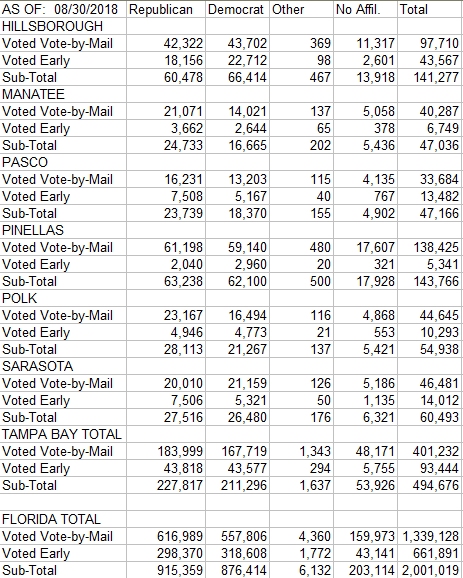- And what to expect in the mid-terms on November 6th.
Click for AUDIO VERSION.
To use this segment in a Radio broadcast or Podcast, send TIM a request.
 The Florida primary was held last Tuesday (Aug 28, 2018), and the field of Republicans and Democrats have been whittled down to one per party. The number of votes cast, and the delegates selected give us a glimpse as to what to expect November 6th, not just here in the Sunshine State, but around the country.
The Florida primary was held last Tuesday (Aug 28, 2018), and the field of Republicans and Democrats have been whittled down to one per party. The number of votes cast, and the delegates selected give us a glimpse as to what to expect November 6th, not just here in the Sunshine State, but around the country.
U.S. SENATE
Rick Scott (R)
Bill Nelson (D)
Comment: This will be a contest between an out-going GOP Governor who reduced unemployment and created jobs, versus a career politician (22 years in the House (11 terms), 18 years in the Senate (3 terms))who followed party lines. Because of his tenure and voting record, Nelson is vulnerable.
Rick Scott (R)
Bill Nelson (D)
Comment: This will be a contest between an out-going GOP Governor who reduced unemployment and created jobs, versus a career politician (22 years in the House (11 terms), 18 years in the Senate (3 terms))who followed party lines. Because of his tenure and voting record, Nelson is vulnerable.
U.S. HOUSE, DISTRICT 12
Gus Bilirakis (R)
Chris Hunter (D)
Comment: Bilirakis is the incumbent, serving since 2007, and is a strong advocate for veterans. He faces a serious challenge in Hunter, a former federal prosecutor and FBI agent.
Gus Bilirakis (R)
Chris Hunter (D)
Comment: Bilirakis is the incumbent, serving since 2007, and is a strong advocate for veterans. He faces a serious challenge in Hunter, a former federal prosecutor and FBI agent.
U.S. HOUSE, DISTRICT 13
George Buck (R)
Charlie Crist (D)
Comment: Former Governor and Republican Crist is the incumbent and ran unopposed as a Democrat. Newcomer Buck has an up-hill battle on his hands.
George Buck (R)
Charlie Crist (D)
Comment: Former Governor and Republican Crist is the incumbent and ran unopposed as a Democrat. Newcomer Buck has an up-hill battle on his hands.
GOVERNOR
Ron DeSantis (R)
Andrew Gillum (D)
Comment: This will be the most visible race in the state and will set the tone for all others. Rep. DeSantis is pro-Trump (having been endorsed by the President), versus anti-Trump candidate Gillum. Gillum surprised a lot of people by defeating Gwen Graham in the primary. His experience primarily includes serving as Mayor of Tallahassee. He is a Progressive and endorsed by Sen. Bernie Sanders.
Ron DeSantis (R)
Andrew Gillum (D)
Comment: This will be the most visible race in the state and will set the tone for all others. Rep. DeSantis is pro-Trump (having been endorsed by the President), versus anti-Trump candidate Gillum. Gillum surprised a lot of people by defeating Gwen Graham in the primary. His experience primarily includes serving as Mayor of Tallahassee. He is a Progressive and endorsed by Sen. Bernie Sanders.
ATTORNEY GENERAL
Ashley Moody (R)
Sean Shaw (D)
Comment: Moody possesses an extensive legal career, including commercial litigation, Federal prosecutor, and Circuit Court judge. Shaw's background is as the state’s Insurance Consumer Advocate. Hand's down, Moody has more experience.
Ashley Moody (R)
Sean Shaw (D)
Comment: Moody possesses an extensive legal career, including commercial litigation, Federal prosecutor, and Circuit Court judge. Shaw's background is as the state’s Insurance Consumer Advocate. Hand's down, Moody has more experience.
AGRICULTURE COMMISSIONER
Matt Caldwell (R)
Nicole "Nikki" Fried (D)
Comment: Caldwell pulled off a bit of a surprise by defeating Denise Grimsley and Baxter Troutman. Caldwell is endorsed by Sen. Marco Rubio and the NRA. He is also an avid Constitutional Conservative. Fried is from Miami, an attorney, and helped expand access to medical marijuana. She claims, "Our politics and our government is broken."
Matt Caldwell (R)
Nicole "Nikki" Fried (D)
Comment: Caldwell pulled off a bit of a surprise by defeating Denise Grimsley and Baxter Troutman. Caldwell is endorsed by Sen. Marco Rubio and the NRA. He is also an avid Constitutional Conservative. Fried is from Miami, an attorney, and helped expand access to medical marijuana. She claims, "Our politics and our government is broken."
And from around the Pinellas County area, we have:
STATE SENATE, DISTRICT 16
Ed Hooper (R)
Amanda Hickman Murphy (D)
Comment: Murphy is a former member of the Florida House. She will be running against Hooper, a career politician who has generated a lot more campaign funds than his opponent.
Ed Hooper (R)
Amanda Hickman Murphy (D)
Comment: Murphy is a former member of the Florida House. She will be running against Hooper, a career politician who has generated a lot more campaign funds than his opponent.
STATE REPRESENTATIVE, DISTRICT 64
James Grant (R)
Jessica Harrington (D)
Comment: Harrington, a school teacher, will be running against incumbent Grant.
James Grant (R)
Jessica Harrington (D)
Comment: Harrington, a school teacher, will be running against incumbent Grant.
STATE REPRESENTATIVE, DISTRICT 65
Chris Sprowl (R)
Sally Laufer (D)
Comment: Former Assistant State Attorney and incumbent Sprowls faces Progressive newcomer Laufer.
Chris Sprowl (R)
Sally Laufer (D)
Comment: Former Assistant State Attorney and incumbent Sprowls faces Progressive newcomer Laufer.
STATE REPRESENTATIVE, DISTRICT 66
Nick DiCeglie (R)
Alex Heeren (D)
Comment: Heeren is another former teacher looking to support his community. He will face DiCeglia who is a business owner and GOP county head. Hard to read this one; could be a coin-toss.
Nick DiCeglie (R)
Alex Heeren (D)
Comment: Heeren is another former teacher looking to support his community. He will face DiCeglia who is a business owner and GOP county head. Hard to read this one; could be a coin-toss.
STATE REPRESENTATIVE, DISTRICT 67
Christopher Latvala (R)
Dawn C. Douglas (D)
Comment: Douglas is a newcomer and another school teacher vying against incumbent Latvala. She may be without the financial resources to adequately fight.
Christopher Latvala (R)
Dawn C. Douglas (D)
Comment: Douglas is a newcomer and another school teacher vying against incumbent Latvala. She may be without the financial resources to adequately fight.
STATE REPRESENTATIVE, DISTRICT 68
Ben Diamond (D)
Comment: Running unopposed, incumbent.
Ben Diamond (D)
Comment: Running unopposed, incumbent.
STATE REPRESENTATIVE, DISTRICT 69
Ray Blacklidge (R)
Jennifer Webb (D)
Comment: Blacklidge is a local attorney and businessman, as well as life-long Republican. Webb is active in her community.
Ray Blacklidge (R)
Jennifer Webb (D)
Comment: Blacklidge is a local attorney and businessman, as well as life-long Republican. Webb is active in her community.
STATE REPRESENTATIVE, DISTRICT 70
Wengay "Newt" Newton (D)
Comment: Running unopposed, incumbent.
Wengay "Newt" Newton (D)
Comment: Running unopposed, incumbent.
NOTE: This list does not include candidates for County Commissioners, School Board, or Fire Commission.
For the complete list of candidates, including the Pinellas County School Board, click HERE.
CRUNCHING THE NUMBERS
Although the election day data has not yet been posted, showing votes by counties and party, the final numbers are in in terms of Votes-by-Mail (absentee) and early voting. The data shown here is most illuminating.
Here we clearly see Republicans like to vote by absentee ballot (write-in), and Democrats prefer early-voting in person.
According to the Florida Department of State, Board of Elections, the number of registered Florida voters eligible to vote in the Primary included:

This means Democrats had the advantage going into the primary election, but allowed Republicans to cast more votes. This implies Democrats still do not like to vote in mid-term elections.
Over 2 million people voted in Florida prior to election day, an admirable number, but it pales in comparison to the 2016 presidential year figures which is typical.
- There were 832,052 less early-votes in the Tampa Bay area than the 2016 election (1,326,728); in other words 62.8% less.
- In Florida, 4,510,659 less early-votes in Florida than the 2016 election (6,511,678); in other words 69.3% less.
REP DEM OTHRS 2016 39.5% 38.0% 19.5% 2018 45.7% 43.8% 10.4%
In other words, from a percentage perspective, Republicans were more active than 2016, and the Democrats did not keep pace. However, notice the "OTHRS" figure, representing independents; as this was a primary, the percentage is down; again, this is to be expected as the primary is a race for the parties. The Independents though are the real prize as that number will go up for the November 6th election.
SO WHAT CAN WE EXPECT GOING INTO THE NOVEMBER ELECTION?
It appears the Republicans are cognizant of what is at stake in this election and are not taking anything for granted. If they lose, and the Congress falls into the hands of the Democrats, they fear their president will face impeachment. They are also deeply satisfied with the economic changes in the country since Mr. Trump entered the White House. As such, Florida Republicans are unified and determined. They are rallying around their President and are showing up in force to vote. At the state level, they fear a liberal agenda will force higher taxes and threaten the second amendment.
If you read the campaign pages of the Democrats, you'll notice a common theme: "Florida is broken," and, "We need to put the interests of the people above those of special interests." The question is, will Independents buy it? The Democrats' problem is they have yet to devise a compelling argument to vote for them, other than to resist President Trump. They also offer the enticement of more freebies, particularly college education, but the taxpayers know they will get stuck with the bill. In other words, the Democrats are stuck in a rut. And please, forget the mantra of Socialism; it will simply not fly down here where people have worked hard all their lives to retire.
What we are about to witness here in Florida, as well as elsewhere across the country, is an ugly brawl pitting the pro-Trump forces against the anti-Trumpers. The real fight is over the votes of the Independents. If they believe the country is better economically and in need of tougher laws on immigration, they will side with the GOP. If not, they will go with the Democrats.
Frankly, I see a "Red Tide" coming to Florida in November, certainly not blue. I would like to believe the other states will follow suit, but I will only comment on Florida herein.
Keep the Faith!
Note: All trademarks both marked and unmarked belong to their respective companies.
 Tim Bryce is a writer and the Managing Director of M&JB Investment Company (M&JB) of Palm Harbor, Florida and has over 40 years of experience in the management consulting field. He can be reached at timb001@phmainstreet.com
Tim Bryce is a writer and the Managing Director of M&JB Investment Company (M&JB) of Palm Harbor, Florida and has over 40 years of experience in the management consulting field. He can be reached at timb001@phmainstreet.com
For Tim's columns, see: timbryce.com
Like the article? TELL A FRIEND.
Copyright © 2018 by Tim Bryce. All rights reserved.
Listen to Tim on WZIG-FM (104.1) in Palm Harbor,FL; Or tune-in to Tim's channel on YouTube. Click for TIM'S LIBRARY OF AUDIO CLIPS.


 Abbot: "Let's see, we have Who on first, What's on second, I Don't Know is on third."
Abbot: "Let's see, we have Who on first, What's on second, I Don't Know is on third."
 It doesn't seem long ago that I would hear someone in the office start the day off with, "Hey, did you hear the one about..." I don't think too many people tell jokes anymore either because we have plugged into some device and tuned out the world, or because we are too sensitive to political correctness.
It doesn't seem long ago that I would hear someone in the office start the day off with, "Hey, did you hear the one about..." I don't think too many people tell jokes anymore either because we have plugged into some device and tuned out the world, or because we are too sensitive to political correctness. This will be my third consecutive year in which I haven't watched the National Football League (NFL). I originally quit because of the thug players who should have been behind bars and not on the gridiron, but when the players started the rukus over the flag, that did it for me. At first, this was hard for me as I had been a fan since the 1960's, but as each year passes, the NFL was slowly divested from my system and, frankly, I do not miss it anymore. This should be cause for concern to the League as there are many people who feel the same way, as indicated by declining viewership. In my eyes, the institution is corrupt and lacks class. All of the athleticism and heroics of the past are gone, and we are left with nothing but overpaid deadbeats on the field, certainly nothing of interest to me. They simply need to clean house, something they are obviously afraid to do.
This will be my third consecutive year in which I haven't watched the National Football League (NFL). I originally quit because of the thug players who should have been behind bars and not on the gridiron, but when the players started the rukus over the flag, that did it for me. At first, this was hard for me as I had been a fan since the 1960's, but as each year passes, the NFL was slowly divested from my system and, frankly, I do not miss it anymore. This should be cause for concern to the League as there are many people who feel the same way, as indicated by declining viewership. In my eyes, the institution is corrupt and lacks class. All of the athleticism and heroics of the past are gone, and we are left with nothing but overpaid deadbeats on the field, certainly nothing of interest to me. They simply need to clean house, something they are obviously afraid to do. At a recent Trump Rally in Tampa, the president put on a clinic for Republican candidates going into the midterm elections. Basically, he is selling prosperity or, to paraphrase an expression from Jerry Maguire, "Show them the money!" More than anything, it is the booming economy that will drive voters in the Fall. If I heard the president correctly, the Mueller probe has essentially burned itself out, the visceral rhetoric of the left is a turnoff to Independents, and the Democrats have nothing to offer except for socialism, higher taxes, and more crime resulting from unprotected borders. It is the economy though, which people seem to grasp, thereby providing more jobs, and allowing workers to earn more money. This is an important lesson for all Republican candidates, be it for Congress, state, county or municipal office.
At a recent Trump Rally in Tampa, the president put on a clinic for Republican candidates going into the midterm elections. Basically, he is selling prosperity or, to paraphrase an expression from Jerry Maguire, "Show them the money!" More than anything, it is the booming economy that will drive voters in the Fall. If I heard the president correctly, the Mueller probe has essentially burned itself out, the visceral rhetoric of the left is a turnoff to Independents, and the Democrats have nothing to offer except for socialism, higher taxes, and more crime resulting from unprotected borders. It is the economy though, which people seem to grasp, thereby providing more jobs, and allowing workers to earn more money. This is an important lesson for all Republican candidates, be it for Congress, state, county or municipal office. Last Friday (Aug 10th), the
Last Friday (Aug 10th), the  INTRODUCTION
INTRODUCTION Here in Florida, as it is in many other states, it is Primary season where political parties select their candidates to run in November. Unlike the general election, I tend to believe Primaries bring out the worst in candidates who inevitably turn to back-stabbing. Back in 1966, Ronald Reagan coined his famous eleventh commandment, "Thou shalt not speak ill of any fellow Republican." Reagan obviously didn't foresee the 21st century as mudslinging is now the norm regardless of what side you are on.
Here in Florida, as it is in many other states, it is Primary season where political parties select their candidates to run in November. Unlike the general election, I tend to believe Primaries bring out the worst in candidates who inevitably turn to back-stabbing. Back in 1966, Ronald Reagan coined his famous eleventh commandment, "Thou shalt not speak ill of any fellow Republican." Reagan obviously didn't foresee the 21st century as mudslinging is now the norm regardless of what side you are on.